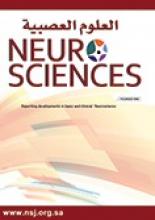Abstract
Diagnosing epilepsy depends heavily on a detailed, and accurate description of the abnormal transient neurological manifestations. Observing the seizures yields important semiologic features that characterize epilepsy. Video-EEG monitoring allows the identification of important lateralizing (left versus right), and localizing (involved brain region) semiologic features. This information is vital for identifying the seizure origin for possible surgical interventions. The aim of this review is to present a summary of important semiologic characteristics of various seizures that are important for accurate seizure lateralization and localization. This would most likely help during reviewing video-EEG recorded seizures of intractable patients for possible epilepsy surgery. Semiologic features of partial and secondarily generalized seizures can be grouped into one of 4 categories including; automatism, speech, motor, and autonomic features. These features will be discussed in detail in this review. However, seizure semiology should be correlated with EEG and MRI findings. Accurate identification of the seizure origin is more likely if focal EEG onset and MRI findings were concordant with the clinical semiology.
- Copyright: © Neurosciences
Neurosciences is an Open Access journal and articles published are distributed under the terms of the Creative Commons Attribution-NonCommercial License (CC BY-NC). Readers may copy, distribute, and display the work for non-commercial purposes with the proper citation of the original work.






